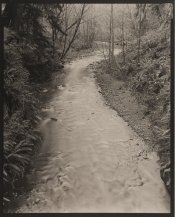bluechromis
Subscriber
- Joined
- Sep 11, 2015
- Messages
- 685
- Format
- 35mm
All art photo images are manipulations. Sometimes people get doctrinaire and make pronouncements that photography should be about an objective rendering of reality with no “manipulations” of the image. When I was 17 years old I remember talking to an older family friend that was a passionate amateur photographer. He was deeply invested in the f/64 “Straight Photography” aesthetic and a had been to numerous workshops with Ansel Adams. Naive as I was, I asked what he thought of the montage images by Jerry Uelsman not knowing what a minefield I was stepping into. He gasped as though I talking of devil and said “Oh no, one must never manipulate the image.” The idea from straight photography is that the photo should be an objective documentation of the external world. But that idea is rubbish, all images that are of value and are interesting are manipulations. Few or no images that are moving and artistically important are literal depiction of the external world. It is a myth, a canard, to think that. Adams himself admitted something to the effect the photo could not be an objective and scientific mapping of the exact tone structor of the original seen because that would be BORING. Instead it was necessary to enhance, to exaggerate certain features. In Adam’s famous “Snake River and Tetons” nobody standing next to Adams as he took the picture would have seen the exact thing depicted in the photo. Instead what the photo shows is something that suggests THE FEELING that someone gets from viewing the magnificent scene. But it’s an abstraction, a romanticization,
inspired by the natural scene, not objective rendering of it—never mind that we don’t see in black and white. There is no such thing as "straight photography" in the way the f/64 school wished for that is an entirely authentic documentation of "the world as it is", not slanted by the perspective of the photographer. No photographs are an exact duplication of reality. When cultural anthropologists got hold of video cameras they were excited because they thought the camera would give a neutral, non-biased way document non-western cultures. But they soon found out that there were huge cultural biases in where the camera operator choose to aim the camera. So yes, even the direction the camera is aimed is a kind of non-objective, value-laden manipulation. As an artistic discipline we need move beyond idea that some images are manipulations and some are not. If one claims some kinds images of not legitimate manifestations of photographic art they need to justify that in terms other than whether an image is manipulated or not, but in terms what kinds of manipulations were done.
inspired by the natural scene, not objective rendering of it—never mind that we don’t see in black and white. There is no such thing as "straight photography" in the way the f/64 school wished for that is an entirely authentic documentation of "the world as it is", not slanted by the perspective of the photographer. No photographs are an exact duplication of reality. When cultural anthropologists got hold of video cameras they were excited because they thought the camera would give a neutral, non-biased way document non-western cultures. But they soon found out that there were huge cultural biases in where the camera operator choose to aim the camera. So yes, even the direction the camera is aimed is a kind of non-objective, value-laden manipulation. As an artistic discipline we need move beyond idea that some images are manipulations and some are not. If one claims some kinds images of not legitimate manifestations of photographic art they need to justify that in terms other than whether an image is manipulated or not, but in terms what kinds of manipulations were done.
Last edited:





 ..
..

